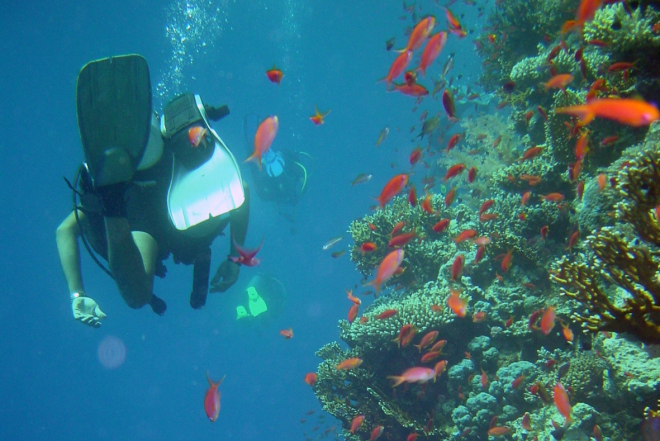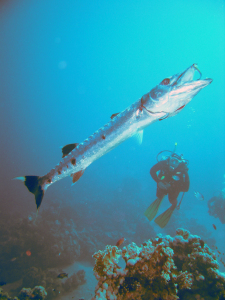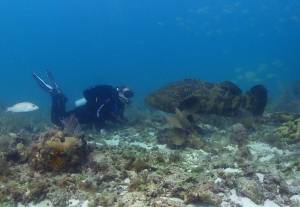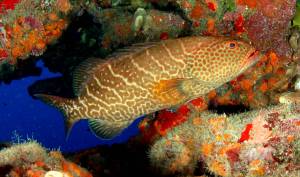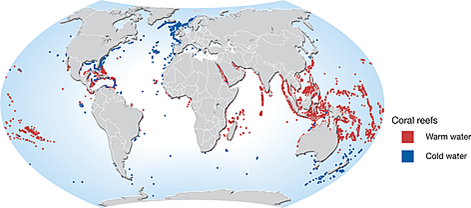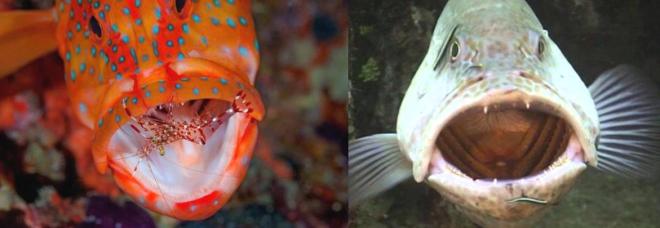The oceans are the least explored place in the world. They are a source of great beauty and value to ourselves as a source of food, water and so many other ‘ecosystem services’, as well as having their own intrinsic value. Marine conservationist Bob Sluka has featured on this blog a number of times, and in this month’s podcast he shares his appreciation of the beauty of the oceans, and how that relates to his faith. This recording (also, transcript below) is an extract from a God in the Lab event at St Andrews Church, Oxford.
My lab is actually in the ocean, and so rather than sitting in the laboratory and looking down a microscope – which I know is amazing as well – I get to spend my time looking into the ocean. I had the misfortune of going to the University of Miami in Florida, and spent a lot of time on the beach as part of the course programme. As part of my doctoral dissertation and post doc research we had a project studying a national park in the Bahamas. So I spent a lot of time boating around the Bahamas and scuba diving. When I tell people that I got my PhD by counting fish they think I’m joking, but actually my job was to go down and count fish.
Beauty face to face
On one of these days, it was the perfect day to be a marine biologist. Some days are rough, you do get seasick and yes I have thrown up under water, I can tell you about that later. But this was one of those perfect days where we were out on the ocean, it was flat calm, we’re speeding along in a skiff and – in my mind – trying to do something that was really important. This was one of the first national parks in the ocean for the Caribbean and we were trying to determine if this national park was actually doing its job. Were the fish bigger inside the park than outside? Was it actually protected from fishing? Was this a good example of a natural Caribbean ecosystem? As we were going along we could almost count the fish from the boat. We went out and anchored up, and could see 80 feet down to the fish we were trying to count there.
Our job on this day was to swim out through the coral reef and go down over the edge of a very deep trench called the ‘Tongue of the Ocean’. We wanted to dive down to 100-110 feet and see what was there, see if there were bigger fish (you usually get larger fish in the deeper water). So we swam out over beautiful coral canyons through crystal clear water and, like the good scientists we were, I said hello to my buddy at the beginning of the dive before going our separate ways to collect our data without much regard for health and safety. So there I was, off on my own hanging out over water which is several thousand feet deep. I’m looking at this wall, with waterproof paper and a pencil and clipboard, and counting fish.
Of course you’ve got all this deep blue behind you and you’re wondering… You get that feeling every once in a while, and you can only turn around very slowly because you’re basically like an astronaut as you’re neutrally buoyant. Then one time I looked down just below me, I could see a couple of hundred feet down, and I just saw something. I was trying to figure out what it was and I kept an eye on it through the rest of the dive. Then as I looked down one time I noticed that it was getting bigger, and it just kept getting bigger, and then something shot past me! I looked around feeling disorientated and I came face-to-face with this fish.
This is a barracuda, and as you see his big teeth, just bear in mind that this fish is as big as I am – and it has this unnerving habit of coming right into your face and looking at you. As it breathes it opens its mouth because it is sucking in the sea water and passing it over its gills. I’m looking deep into its big eyes, he’s looking at me, and of course I’m a bit afraid. But then I also thought, OK it’s a barracuda, it’s clear water, this thing is not going to eat me – it’s not even going to bite me in fact.
Then my fear turned into this idea of awe, of wonder. The feeling that captured me was the beauty of this animal, and the beauty of the situation. As I sat there I thought to myself, “This is something worthwhile to do. Here I am, I get to be out here studying and protecting these creatures.” Beauty was a huge driver in my desire to protect these animals – to study them. Beauty has been something that has really drawn me to the Lord through the things that he has made.
Beauty and theology
Now Ruth gave a really good three-point model from Alister McGrath, to think about awe and wonder in her book. She also talks about theologian Jame Schaefer. What I want to do is to talk about the model that Schaefer gives for thinking about beauty. It is structurally very similar to what Alister McGrath does, but it has five points. I’ll go through this quickly, and using examples from some of the fish that I study, explain how I try to apply this to things I have learnt in science.
First is this idea of simple delight. It is an emotional appreciation that doesn’t really require great thought or deep insight. You see it, it’s beautiful and that’s the end of it. Secondly, there is in-depth study. As a result of studying what you see in greater detail you can appreciate the beauty in it much more. Thirdly, there exists more of an abstract appreciation. It becomes an abstraction of what you’re seeing and I’ll try to explain that with an example. Then there comes a point of mystery and incomprehensibility in what we’re seeing. We get to a point where either we can’t understand it or the complexity is so great that it involves an area of mystery. This then again helps us to enjoy its beauty. Finally, there is what is called sacramental appreciation. This word usually has a very specific theological meaning (not to get hung up on it). We’re not talking about being a sacrament as we usually talk about it, but these are things that for us as Christians can remind us of the invisible God’s presence and character.
So let’s take this five-point model and look at a group of fish that I studied in the past, called grouper. There are about 150 different species of grouper throughout the world.
This is one of the largest of the species; they also get very small. This is a species I have seen underwater. When you come across this big animal – some of them are as big as a truck – it’s just a simple delight to see this beautiful creature.
Many of them have beautiful colours so you can see bright purples and spots. These are all species of this family of fish. This is a Tiger Grouper from the Caribbean. It was one of my favourite when I was diving as a graduate student. They were fairly rare, beautiful animals. When you came across one you would just simply delight at the variety and beauty of these creatures.
Then we begin to study these animals in a little bit more depth. I was looking at the habitat of these species. We can see it as beautiful, but then we look closer and actually you can see it’s hanging out in a cave. When I was doing my research we used a technique called transect lines. You have a reel or rope and you lay it out along the bottom and search a set area either side of the line to count the fish and see how many are there. We did this in different types of habitat to try and see which fish lived in which habitats. So, for example, you often have to be looking under and inside of these caves. So you get the sense of anticipation. Then this guy [Tiger Grouper above] pops out and that sense of habitat can enhance your ideas of beauty.
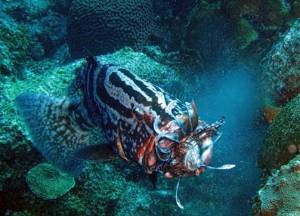 This is a grouper eating a lionfish. It has poisonous spines. People like them for their aquariums but the problem is that when they get tired of them or they move, they let them go into the ocean. This has happened around Miami. The problem is that this species of fish doesn’t live in the Caribbean – it’s an indo-Pacific fish. Now the Lionfish has spread throughout the Caribbean and there are, as far as we know, no natural predators for it. So these groupers may be the ones that eat it. Because I know that this is an invasive species and I can see this grouper eating it – even though it’s a life or death struggle, there is a way to appreciate that. This fish might actually be evolving its behaviour to eat something it has never seen before. It gives me a sense of real joy to see that beauty.
This is a grouper eating a lionfish. It has poisonous spines. People like them for their aquariums but the problem is that when they get tired of them or they move, they let them go into the ocean. This has happened around Miami. The problem is that this species of fish doesn’t live in the Caribbean – it’s an indo-Pacific fish. Now the Lionfish has spread throughout the Caribbean and there are, as far as we know, no natural predators for it. So these groupers may be the ones that eat it. Because I know that this is an invasive species and I can see this grouper eating it – even though it’s a life or death struggle, there is a way to appreciate that. This fish might actually be evolving its behaviour to eat something it has never seen before. It gives me a sense of real joy to see that beauty.
Schaefer, in talking about Basil of Caesarea, says “his astute observations seemed to intensify his appreciation for them. He urged his listeners to pay attention to all the creatures, to never cease admiring them and to give glory to God for them.”
We can then move on to this idea of abstract appreciation using the same picture. Now that we know about the expansion of these Lionfish all over the Caribbean, you can get this sort of abstraction of – the Grouper is a fish that, if we don’t protect it, is one of the few things that eat these lionfish. If we’re overfishing the grouper then we potentially have a very real problem for the entire Caribbean. Should we be eating this animal that is 60 years old or more? What are the implications of these things? These are abstract ways of thinking about the beauty of these creatures. I’m not much of a fisherman, I just like to see them underwater. But there is a sense of anticipation when you’re fishing. You bring this fish up and “what’s it going to be?” But what are the implications of that for their ecology?
We then get to mystery and incomprehensibility. As I thought about how to express this, I thought about all the things going on within fish species, on reefs throughout the world. There are all these interactions happening right now, day and night and it gets to a point where it’s overwhelming. How is all this stuff going on?
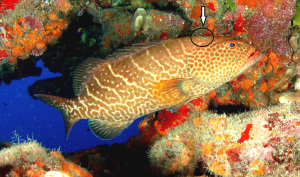 Lastly, we get to the sacramental. Up in the corner of the cave you see a small fish you didn’t see before. Maybe you thought it was part of the animal. It is actually a cleaner goby that lives in caves like this. The fish comes in and the goby goes over them and cleans off the little parasites. The fish will open its mouth, and you see its big teeth. Normally these are fish-eaters (piscivores), and they eat little fish. But the gobies do a dance and signal to the grouper that they want to clean him. They’ll go and pick off dead tissue and clean the parasites off.
Lastly, we get to the sacramental. Up in the corner of the cave you see a small fish you didn’t see before. Maybe you thought it was part of the animal. It is actually a cleaner goby that lives in caves like this. The fish comes in and the goby goes over them and cleans off the little parasites. The fish will open its mouth, and you see its big teeth. Normally these are fish-eaters (piscivores), and they eat little fish. But the gobies do a dance and signal to the grouper that they want to clean him. They’ll go and pick off dead tissue and clean the parasites off.
To me, when Schaefer talks about things being sacramental, for me it gives a picture of God’s provision for us. This one fish has parasites, but there’s another fish which cleans the parasites. It reminds me of Psalm 104, that goes through all the ways in which God provides for the different creatures. I would suggest that this type of sacramental thinking has to be really intentional. It may seem a leap from this cleaner wrasse to God’s provisioning for us, but the beautiful things can remind us of the things that God has done for us.
I want to leave you then with this quote from Basil of Caesarea: “From the beauty of the visible things let us form an idea of him who is more than beautiful.” As we know, there are huge problems in the ocean. There is overfishing, climate change and pollution. We have ways of dealing with these problems, to preserve the beauty of the ocean – particularly through these national parks. One great experience of being in the ocean for me is that I have essentially (not literally) taken the word of God down into the ocean. As I’ve thought about scripture, and as I have interacted with the ocean, it has enhanced my faith. It has allowed me to think theologically about the beauty that I see, and I would encourage you, whatever your job or vocation, that this type of model could be applied to that. It takes some intentionality!




